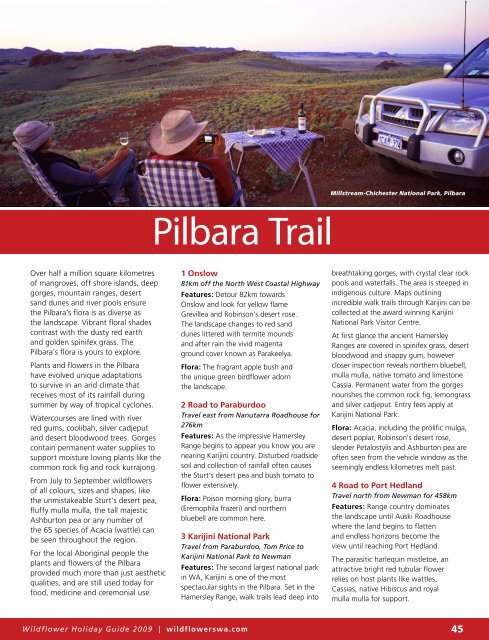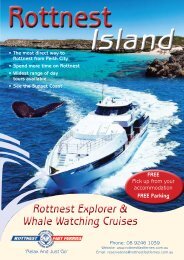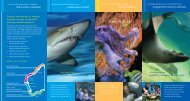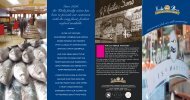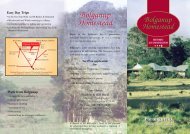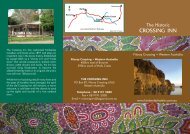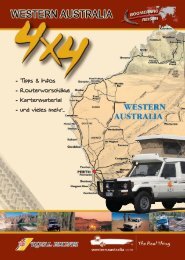Wildflower Holiday Guide - Western Australia
Wildflower Holiday Guide - Western Australia
Wildflower Holiday Guide - Western Australia
Create successful ePaper yourself
Turn your PDF publications into a flip-book with our unique Google optimized e-Paper software.
Over half a million square kilometres<br />
of mangroves, off shore islands, deep<br />
gorges, mountain ranges, desert<br />
sand dunes and river pools ensure<br />
the Pilbara’s flora is as diverse as<br />
the landscape. Vibrant floral shades<br />
contrast with the dusty red earth<br />
and golden spinifex grass. The<br />
Pilbara’s flora is yours to explore.<br />
Plants and flowers in the Pilbara<br />
have evolved unique adaptations<br />
to survive in an arid climate that<br />
receives most of its rainfall during<br />
summer by way of tropical cyclones.<br />
Watercourses are lined with river<br />
red gums, coolibah, silver cadjeput<br />
and desert bloodwood trees. Gorges<br />
contain permanent water supplies to<br />
support moisture loving plants like the<br />
common rock fig and rock kurrajong.<br />
From July to September wildflowers<br />
of all colours, sizes and shapes, like<br />
the unmistakeable Sturt’s desert pea,<br />
fluffy mulla mulla, the tall majestic<br />
Ashburton pea or any number of<br />
the 65 species of Acacia (wattle) can<br />
be seen throughout the region.<br />
For the local Aboriginal people the<br />
plants and flowers of the Pilbara<br />
provided much more than just aesthetic<br />
qualities, and are still used today for<br />
food, medicine and ceremonial use.<br />
Pilbara Trail<br />
1 Onslow<br />
81km off the North West Coastal Highway<br />
Features: Detour 82km towards<br />
Onslow and look for yellow flame<br />
Grevillea and Robinson’s desert rose.<br />
The landscape changes to red sand<br />
dunes littered with termite mounds<br />
and after rain the vivid magenta<br />
ground cover known as Parakeelya.<br />
Flora: The fragrant apple bush and<br />
the unique green birdflower adorn<br />
the landscape.<br />
2 Road to Paraburdoo<br />
Travel east from Nanutarra Roadhouse for<br />
276km<br />
Features: As the impressive Hamersley<br />
Range begins to appear you know you are<br />
nearing Karijini country. Disturbed roadside<br />
soil and collection of rainfall often causes<br />
the Sturt’s desert pea and bush tomato to<br />
flower extensively.<br />
Flora: Poison morning glory, burra<br />
(Eremophila frazeri) and northern<br />
bluebell are common here.<br />
3 Karijini National Park<br />
Travel from Paraburdoo, Tom Price to<br />
Karijini National Park to Newman<br />
Features: The second largest national park<br />
in WA, Karijini is one of the most<br />
spectacular sights in the Pilbara. Set in the<br />
Hamersley Range, walk trails lead deep into<br />
Millstream-Chichester National Park, Pilbara<br />
breathtaking gorges, with crystal clear rock<br />
pools and waterfalls. The area is steeped in<br />
indigenous culture. Maps outlining<br />
incredible walk trails through Karijini can be<br />
collected at the award winning Karijini<br />
National Park Visitor Centre.<br />
At first glance the ancient Hamersley<br />
Ranges are covered in spinifex grass, desert<br />
bloodwood and snappy gum, however<br />
closer inspection reveals northern bluebell,<br />
mulla mulla, native tomato and limestone<br />
Cassia. Permanent water from the gorges<br />
nourishes the common rock fig, lemongrass<br />
and silver cadjeput. Entry fees apply at<br />
Karijini National Park.<br />
Flora: Acacia, including the prolific mulga,<br />
desert poplar, Robinson’s desert rose,<br />
slender Petalostylis and Ashburton pea are<br />
often seen from the vehicle window as the<br />
seemingly endless kilometres melt past.<br />
4 Road to Port Hedland<br />
Travel north from Newman for 458km<br />
Features: Range country dominates<br />
the landscape until Auski Roadhouse<br />
where the land begins to flatten<br />
and endless horizons become the<br />
view until reaching Port Hedland.<br />
The parasitic harlequin mistletoe, an<br />
attractive bright red tubular flower<br />
relies on host plants like wattles,<br />
Cassias, native Hibiscus and royal<br />
mulla mulla for support.<br />
<strong>Wildflower</strong> <strong>Holiday</strong> <strong>Guide</strong> 2009 | wildflowerswa.com 45


